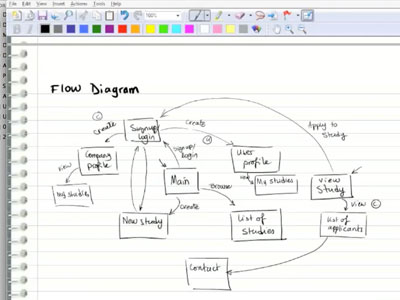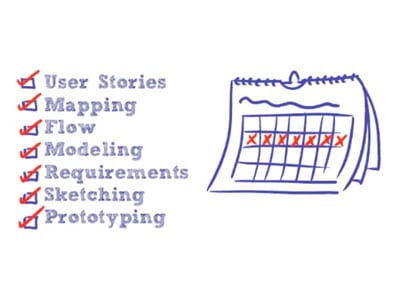This is a review of the online course Design Your User Experience in 7 Simple Steps, by Amir Khella. The author was not paid for this review.
Our list of online UX courses is one of the most popular pages on this site. However, we’re aware that such a list—as with our collection of books and tools—would be that much more useful if it contained additional information about each entry. While we can’t promise to review every single online UX course out there, we thought we’d start by writing some reviews.
Read some of our other reviews or browse the full list of online UX courses.
Course Information
- Course Name: Design Your User Experience in 7 Simple Steps
- Author: Amir Khella
- Hosted by: udemy
- Length: 7 lectures + bonus material (approx 2.5 hours of video, intended to be viewed over the course of one week)
- Intended Audience: beginners, developers, entrepreneurs
- What You’ll Learn: A “lean UX” style process for turning an idea into a collection of sketches that can be polished, refined, and implemented.
- What You Won’t Learn: Hands-on techniques for performing user research; visual design principles
- Assumed Knowledge: None, although some references are made to technical concepts
- Price at time of review: US $197
Review
Overall I thought this was a well structured, solid introduction to the process of designing a digital product.
The Presenter
Amir Khella is a developer-turned-entrepreneur who studied human-computer interaction, and has since applied his user experience design knowledge on 12 successful startups over a period of three years. He uses a tablet computer to draw the slides for each lecture, which is like looking over his shoulder as he makes notes and captures this thought processes.

I like this approach, as it felt like I was getting a peek into the inner workings of Khella’s mind as he stepped through the process of designing the fictitious web app, Usermatic.
Target Audience
The course is targeted at beginners to UX—primarily, entrepreneurs who have a product idea to flesh out, or developers who want to learn the basics of designing a software product. Students will learn a process that can be used to flesh out which screens the app should contain, how users flow between screens, and what UI elements should exist on each screen.
Khella uses a very hands-on approach—students are stepped through the design of a sample web app, from concept through to a collection of sketches that could be given to a graphic designer to polish, or to use as a basis for building a low-fidelity prototype.
Different Learning Styles
The udemy in-browser experience is excellent. The video streaming is quick, navigating between different lectures uses slick transitions, and I liked being able to easily pick up where I left off at any stage. There is also the capacity to ask questions, although there are a few questions that seem to have gone unanswered for months at a time before receiving a response from the author.
Another positive—the author has also gone to the trouble of providing a downloadable version of every lecture—in video and audio format—for those who may like to learn while at the gym or sitting on a mountain top with no network connection.

Where’s the User?
The only real criticism I have of the course is the lack of material on how to solicit actual user input—goals, tasks, and motivations. Being an entrepreneur, Khella is a proponent of the “Lean UX” approach that sees product designers placing themselves in the user’s shoes, sketching ideas, then rapidly testing those sketches. This is a totally valid approach for a one-person team eager to push a brand new product out the door, but it won’t work in every instance—a lack of sufficient user research in some cases may result in you designing the wrong product or missing some of the key motivations driving your users.
So while Khella advocates the use of A/B testing, he doesn’t address the topic of understanding the “why” of UX Design. On small projects, this may not matter; on larger sites with bigger budgets, it’s crucial.
Pros
- Well structured, well paced content from a knowledgable presenter.
- Utilizes a realistic case study that you can “play along with at home” to understand the design process.
- Tackles several design problems that are non-trivial, rather than relying on an overly simplistic example to sidestep complex issues.
- Gives good insights into a process for sketching thumbnails and multiple variations of a user interface.
- Touches on aspects of basic design principles, such as the use of UI patterns, simplicity, focus and information hierarchy.
- Provides a framework for designing a functional, usable website that could be repeated on other projects.
- Touches on the difference between designing for mobile and web apps.
Cons
- Makes some assumptions relating to technical knowledge of databases and object-oriented programming.
- Doesn’t cover any user research topics, such as how to profile, survey, interview, monitor, test or segment your product’s users, or validate your product in the first place.
- Doesn’t cover many interaction design principles, such as transitions and states.
- Describes a process for designing a new product, but not how to redesign an existing product.
- Intertwines theory with case study material. This is not necessarily a bad thing as it is an effective technique for demonstrating a principle but makes it difficult to grasp concepts for retention.
- Doesn’t cover emotional design at all, such as how to add delight or other elements of surprise that can “wow” your users.

Summary
Overall, Design Your User Experience In 7 Simple Steps is a solid, well-structured introduction to UX Design for newcomers. It will particularly resonate if you consider yourself to be more analytical than creative—for example, you come from a technical or entrepreneurial background and want to “just do the UX yourself” as compared to forging a career as a UX Designer. The course provides a comprehensive walkthrough of a realistic web app design, from initial idea through to sketched wireframes of the user interface. The presenter does a good job of explaining each step and providing anecdotal tips along the way.
The biggest piece I felt was missing was a section on how to solicit user input and perform research—the example project begins with user stories already captured, but no insight is provided into how to determine whether the two user profiles used mirror the actual user base, or whether these stories accurately reflect the needs of these users. The entire course covers techniques performed in isolation, not with others—the User in “User Experience” is mentioned, but never actually consulted. That said, if you have an idea for a new product and are motivated to create a prototype as quickly as possible, this course will be just what the doctor ordered.
- Content (how useful, up to date, practical, and comprehensive): 7/10
- Delivery (presentation style, pace, clarity, authority): 8/10
- Production (video quality, audio quality, editing): 7/10
- User Interface (reliable infrastructure, usable interface, convenient): 9/10
- Overall rating: 7½/10
Table Of Contents
Introduction
- Introduction
- Defining the problem
The 7 Steps
- Creating user stories
- Drawing the system map
- Designing the flow
- Modelling the attributes
- Creating screen requirements
- Sketching the user interface
- Adding details to the sketches
Bonus Material
- UX Process Cheat Sheet
- UX for mobile devices
- Rapid Prototyping
- Six mistakes you should avoid when doing user testing
The Design Your User Experience In 7 Simple Steps course is hosted at udemy.
Note: This post contains affiliate links, so if you do decide to enrol in the course, we’ll receive a percentage of the sale, which will help pay the hosting bills.






Thank you for this, Matthew! These reviews will be a great addition to your list of online UX courses.
Thanks Gisele! Glad you found it useful.